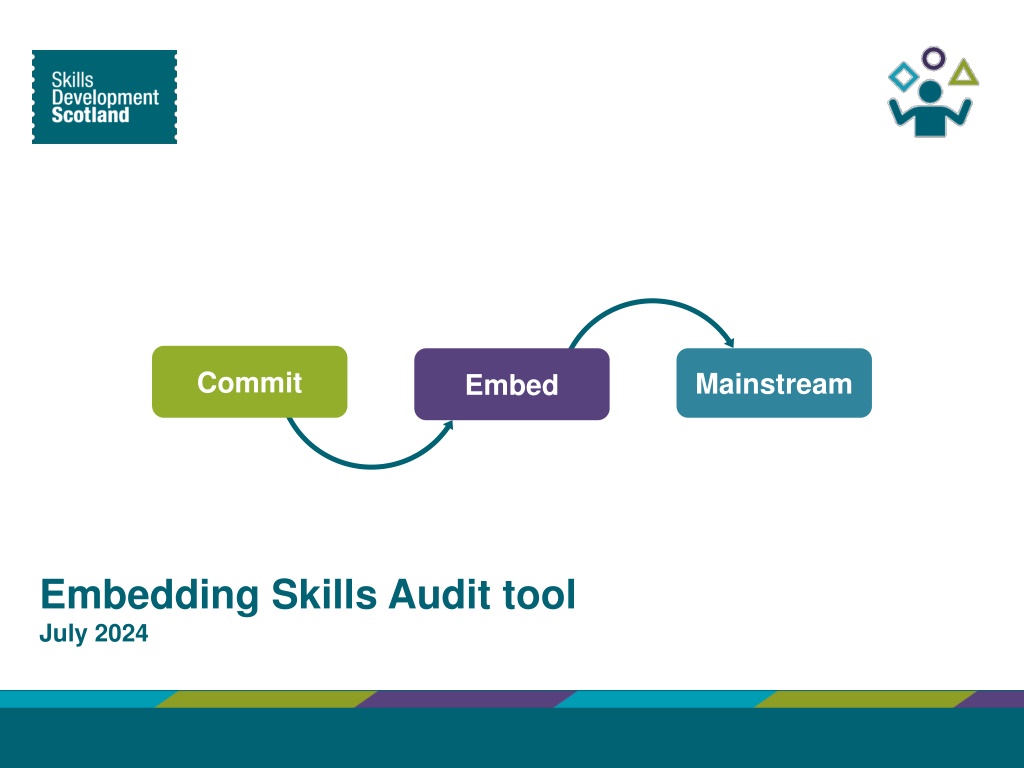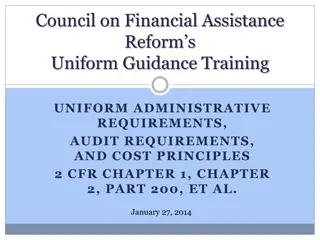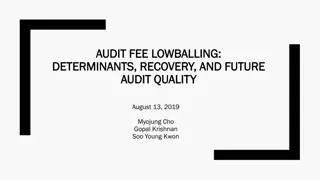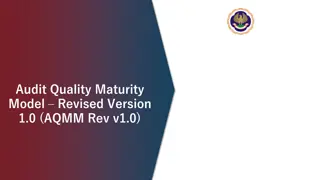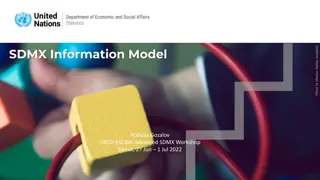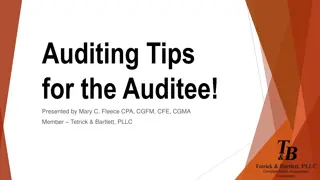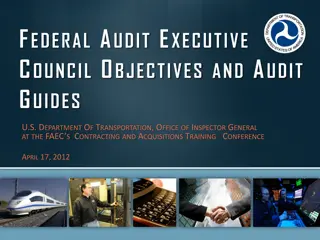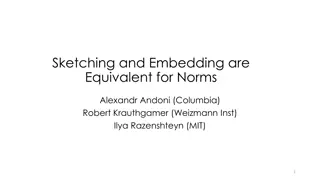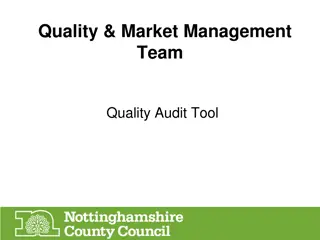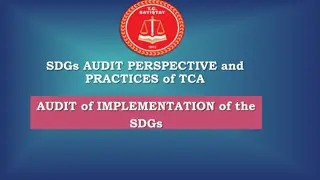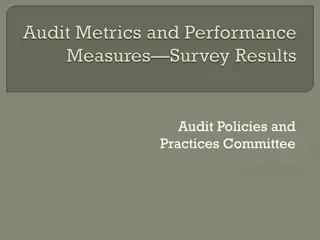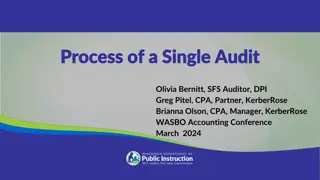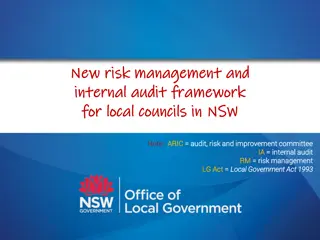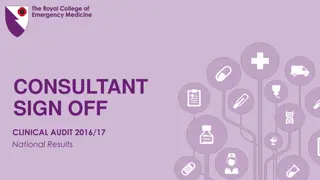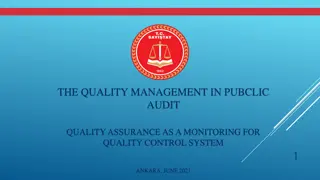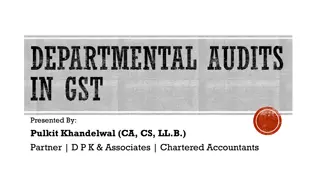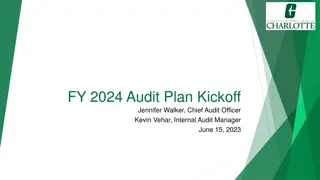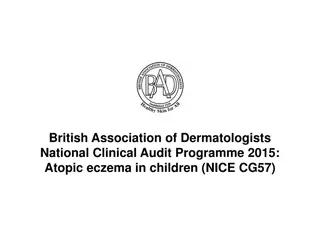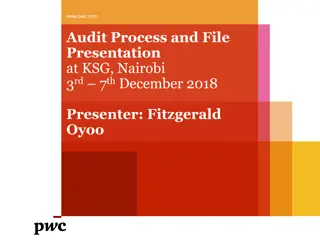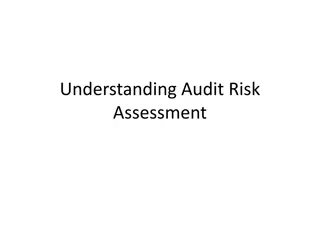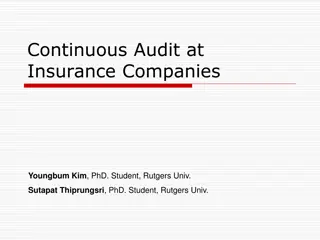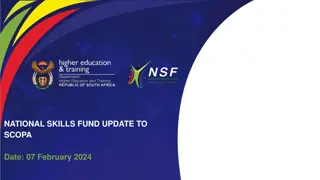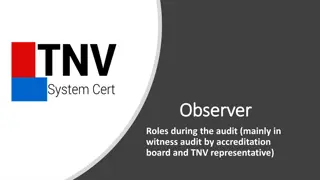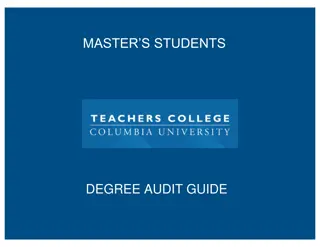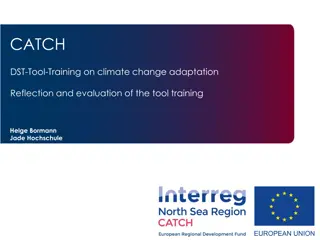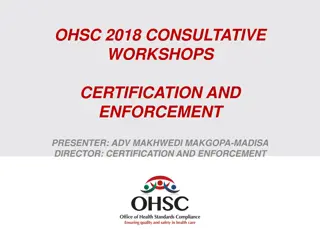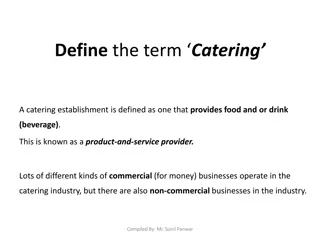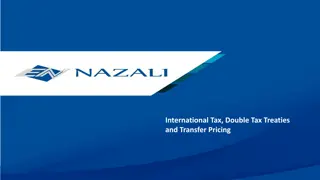Embedding Skills Audit Tool: Self-Evaluation Guide for Establishments
The Embedding Skills Audit Tool is designed to help establishments self-evaluate their skills approach against illustrative statements for the commit, embed, and mainstream stages. This tool provides guidance on scoring, focused discussions, and action planning to enhance skills implementation. By following the outlined steps, establishments can identify strengths, challenges, and opportunities for improvement in their skills approach. Utilize this tool to assess and enhance your establishment's skills strategy effectively.
Download Presentation

Please find below an Image/Link to download the presentation.
The content on the website is provided AS IS for your information and personal use only. It may not be sold, licensed, or shared on other websites without obtaining consent from the author. Download presentation by click this link. If you encounter any issues during the download, it is possible that the publisher has removed the file from their server.
E N D
Presentation Transcript
Commit Mainstream Embed Embedding Skills Audit tool July 2024
Embedding Skills Audit tool Embedding skills audit tool The following guidance outlines how the embedding skills audit tool can be used by establishments to self-evaluate the implementation of their skills approach. It is based on embedding skills approach outlined on page 5 of A Guide to Meta-skills Across the Curriculum . What is the embedding skills audit tool? The embedding skills audit tool supports establishments to self-evaluate their skills approach against illustrative statements highlighting good practice within the commit, embed and mainstream stages of embedding skills. How to use the embedding skills audit tool? It is important that a suitable amount of time is set aside to complete the audit tool and allow for meaningful reflection and discussion. Establishments should use the embedding skills audit worksheet and illustrative statements to support them going through the following 3 steps: Step 1: Scoring Taking each statement in turn, establishments should read through the illustrative statements and assess whether they are at the emerging, progressing or fully established stage. Emerging is depicted by a score of 1-2 Progressing is depicted by a score of 3-4 Fully established is depicted by a score of 5. These examples are not the only ways in which these statements could be scored, and we would ask you to use your own judgement (supported by evidence) when considering your position against the statements. Establishments can add other examples to determine their score. After reflection, note down the identified score for each statement. Once initial scoring has been completed, assess the overall picture and identify what statement(s) you would like to discuss in more detail and action plan against. The commit stages give the foundations to a skills approach, and it is advised to concentrate on this stage first if your scoring does not reflect strong foundations in which to build on the embed and mainstream stages.
Embedding Skills Audit tool Embedding skills audit tool Step 2: Focused discussion Assess which statement(s) you want to focus on and, using the discussion prompts below to support you if necessary, discuss what is going well, what are the challenges, what are the opportunities. What are we doing well? What are the positives? What benefits have you seen in the work you have done so far? What does success look like to us and our learners? What evidence do we have to support our score? For example: policy, framework, surveys, and observations. What are the challenges? What are the challenges to fully establish this statement? Has anything stopped us from progressing with this statement before? What areas can we improve/build on? What are the opportunities? What opportunities are there to fully establish this statement? Are there examples of good practice out with this establishment that we could learn from? Can we think of any solutions to any challenges we have identified? What would the benefits be if we fully established this statement? Step 3: Action planning Based on reflections, identify what your next steps will be, using the discussion prompts below to support you if necessary: What are our next steps? What one thing could we change in our practice/approach that could make the biggest difference right now? What improvement actions can we identify for the terms ahead? What resources do we have/need? What support do we need? If you would prefer a facilitated workshop to take you thought the skills audit tool or would like to speak with someone from the National CIAG Education Team about your results, please email education@sds.co.uk
Embedding Skills Audit tool Embedding skills: commit stage Commit Emerging (Example score 1) Progressing (Example score 3) Fully Established (Example score 5) The skills agenda has not yet been highlighted as a priority within the school improvement plan/strategic plan and does not currently inform curriculum rationale. The skills agenda has been identified as a priority within the school improvement plan/strategic plan and improvement actions have been identified. The skills agenda has been identified as a priority within the school improvement plan/strategic plan which informs curriculum rationale and department level work plans. Commit (i): The skills agenda has been identified as a priority within the school improvement plan/strategic plan and actions for improvement have been captured at whole school/college and department level. This priority has not yet filtered into department level work plans and no department improvement actions have been identified. Improvement actions are reviewed on an ongoing basis A common skills framework has not yet been established or a previous skills framework is no longer working. A common skills framework has been established and shared with all practitioners within the establishment. A common skills framework has been established and all staff understand the importance of this. Commit (ii): Practitioners understand the importance of having a common skills language and a skills framework for the establishment has been agreed and shared with key partners. A common skills language has not yet been embraced across the curriculum. The importance of having a skills framework is understood and has been embraced by most practitioners. The skills framework has been shared with all key partners (cluster primaries, secondary, local college, parent and carers) to ensure strengthened understanding of the skills by learners. Practitioners are using a range of skills language with learners and there is no commonality across the establishment. The skills framework has not yet been shared with key partners. There is no skills policy/ overarching documentation/ clear communications explaining staff roles and responsibilities to embed the framework A skills policy or clear communication has been developed detailing the roles and responsibilities of staff to embed the skills framework. A skills policy or clear communication has been developed detailing the roles and responsibilities of staff to embed the skills framework. Commit (iii): Roles and responsibilities of practitioners to embed the skills framework has been made clear and all practitioners understand the language within the framework. Staff training has not yet been offered. Training has been provided to support staff throughout the beginning of their embedding skills journey. All staff understand the language of the framework and their roles and responsibilities in embedding this at classroom level. There is confusion about the language within the skills framework. There are some inconsistencies with staff understanding their role and responsibility in embedding the skills framework. Practitioners do not understand their role and responsibility in embedding the skills framework. Training needs are reviewed on an ongoing basis to support staff. A working group has been set up to drive forward the skills agenda for the establishment. An established working group is driving forward the skills agenda. They are a point of contact for any member of staff who wants to feedback issues re roles and responsibilities of staff and language. No practitioners have been identified to drive forward the skills agenda for the establishment.
Embedding Skills Audit tool Embedding skills: commit stage Embed Emerging (Example score 1) Progressing (Example score 3) Fully Established (Example score 5) When planning learning, practitioners do not consider the skills framework and therefore opportunities to develop skills are not yet recognised. When planning learning, practitioners consider the skills framework and plan how to bring skills into focus during lessons. All staff across the curriculum (and all year groups) plan their lessons to include the skills that will be focused on during the lesson. Embed (i): All practitioners across the curriculum are making the skills framework visible to learners and are embedding skills at classroom level. Skills are not yet included within learning intentions and success criteria. Skills within the framework are made visible and are included within learning intentions and success criteria, but this not consistent across the curriculum. Skills are consistently incorporated into learning intentions and success criteria. Skills posters and iconography are displayed but no reference is being made to them. Practitioners across all departments focus on all skills within the framework and incorporate these into lessons. Practitioners concentrate on a small number of skills and do not focus on the totality of skills within the framework. Practitioners consistently use effective questioning as part of learner conversations and restorative conversations to support learners metacognition about skills and encourage deeper understanding. Skills conversations mainly occur at transition points, such as P7 transition, senior phase employability programme and during skills academy courses and other vocational qualification lessons. There is no standard approach for learners to have time to reflect on their skills development. There is an approach for learners to have time to reflect on their skills development, but this is not consistent across the curriculum. A systematic approach to profiling as been established. Embed (ii): Learners have regular opportunities to reflect on and record their skills development across the curriculum. Learners are provided with the resources, space and time to update their profile to reflect their latest and best skills development throughout the curriculum and wider achievements. Learners do not record their skills development across all stages of learning. Learners are mainly encouraged to reflect on their skills episodically at key times such as S3 profiling, as part of DYW initiatives, vocational pathways or at transition points. The establishment has a system in place to allow learners to record skills development which is used across all departments. The establishment has a system in place to allow learners to record skills development, but this is not yet used across all departments.
Embedding Skills Audit tool Embedding skills: commit stage Mainstream Emerging (Example score 1) Progressing (Example score 3) Fully Established (Example score 5) A formal approach for practitioners to feedback any challenges or interesting practice around embedding skills has not yet been established. A formal approach for practitioners to feedback any challenges or interesting practice around embedding skills has been established but is mainly shared within departments and not across the whole establishment. A formal approach for practitioners to feedback any challenges or interesting practice around embedding skills has been established and practice is shared across the whole establishment. Mainstream (i): An approach has been established for practitioners to feedback and share practice The sharing of practice is adhoc and informal. Sharing practice regarding the embedding skills approach is scheduled into the agenda on an agreed timescale (e.g. per term) across the whole establishment. Sharing practice regarding the embedding skills approach is scheduled into the agenda on an agreed timescale (e.g. per term) at department level but is not yet agreed across the establishment. Any challenges, best practice examples and opportunities are not captured, shared or actioned. Any challenges, best practice examples, opportunities or improvement actions are reviewed on an ongoing basis across the whole establishment. Any challenges, best practice examples and opportunities are captured and actioned at department level. There is no joined up approach across key partners to embedding the skills framework. The secondary school are mainly working in collaboration with associated primaries to ensure a smooth transition process for learners and parents and carers to understand how the skills within the framework are transferable from primary to secondary. All key partners are working in collaboration to ensure smooth transition processes across the learner journey (from primary to secondary to college and other pathways beyond school). Mainstream (ii): Establishments work in collaboration with their key partners to ensure a consistent approach to skills development across the learner journey. There is no transition report/profile in place that follows the learner from one education establishment to another that captures skills development. There is a consistent approach in place for transition reports/profiling which captures skills development and follows the learner from one education establishment to others. There is a transition report/profile in place to capture skills development that follows the learner from one education establishment to another but this approach is not consistent for all learners. Employer partnerships have been established but employers do not collaborate with practitioners to codesign and co-deliver learning experiences to inform learners about how their skills are transferable to the workplace. Examples of key partners: - associated primaries/secondary school - local colleges - local employers - local training providers - CLD partners - parents and carers Strong employer partnerships have been established and all key partners collaborate with practitioners to co-design and co-deliver learning experiences to inform learners about how their skills are transferable to the workplace. Employer partnerships have been established and some key partners collaborate with practitioners to co-design and co-deliver learning experiences to inform learners about how their skills are transferable to the workplace. Parents and carers are not currently involved in informing and supporting the establishments approach to skills development. There is an approach for all parents and carers to be involved in informing and supporting the establishments approach to skills development. Some parents and carers (e.g. parent councils) are involved in informing and supporting the establishments approach to skills development.
Embedding skills audit tool: Worksheet Establishment: Date: Step 1: Scoring Step 2: Focused discussion Record scores for each stage below: What are we doing well? What are the challenges? What are the opportunities? Commit (i) Commit (ii) Commit (iiI) Embed (i) Embed (ii) Mainstream (i) Mainstream (ii) What stages(s) will be concentrated on during the focused discussion? Step 3: Action planning Quick Wins Medium-term actions Long term actions Resources required
